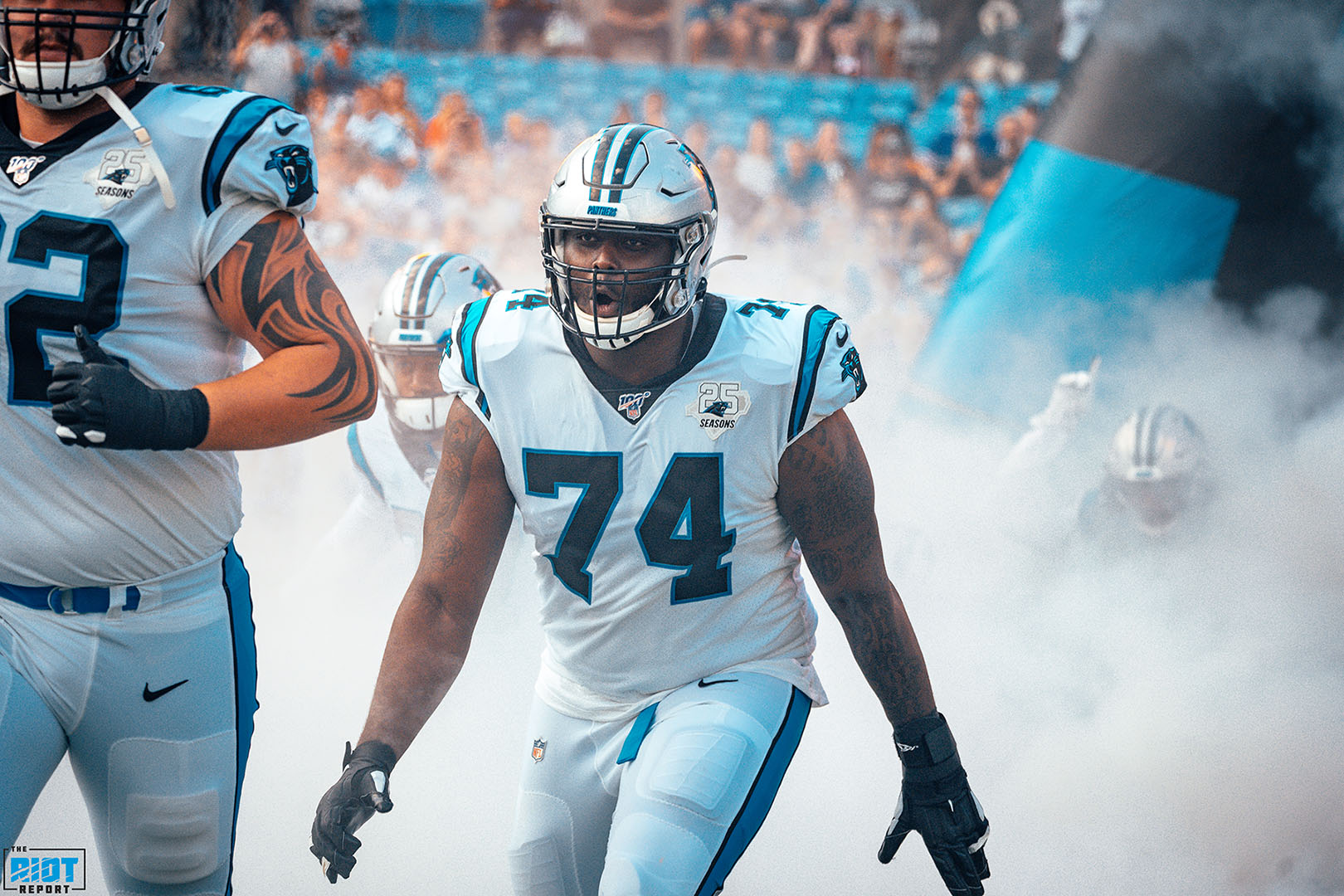Passing Game
However, the major reason why the Panthers felt the need to invest in an offensive tackle in the second round of the draft was to improve the protection for Cam Newton, and so how Little gets on as a pass protector is likely to play a major part in determining how quickly he sees the field. There were certainly a number of plays against the Bills where he showed exactly what made him so unique as a draft prospect, with the foot speed, knee bend and balance to follow speed rushers around the edge without having to make sacrifices technically:
He was also able to pair this, as he did in the running game, with good hand usage, showing both the hand speed to counter the moves of the edge rushers as well as the length and location to get inside hand placement which then allowed him to control the block:
However, as he did against the Bears and at times throughout his college career, he still produced a few frustrating plays from a hand usage point of view that coaches will want to try and eradicate completely from his game. The most obvious of these was the following play, where he drops his hands away from his frame, meaning his punch is wild and not directed to the frame of the defender, making it easy for the defender to swat aside and put Little off-balance:
Fixing this is just a matter of bringing his arms together and up, allowing him to direct his punch more easily and with more control. The other, more persistent issue is his tendency to lean and punch at the very limit of his reach rather than waiting for the defender to get closer to him. What this means is that his punch both takes longer to the defender, giving him more time to react, and that if his punch doesn’t hit, he is then left with his momentum all going forward, making it easy to work him off balance and hard for him to recover effectively:
If he can work on timing his punch so that he is able to keep his back more upright and look to engage only his arms, this should allow him to keep his weight over his feet more effectively and make it harder for a defender to counter. The other issue that has been somewhat persistent is his habit of getting too far outside the defender, thereby opening up an inside rushing channel which, if the defender looks to attack, leaves Little trying to block at an angle and facing an uphill battle in order to prevent pressure:
This is an issue that is far more mental than physical, as Little has the foot speed to cover around the edge, but seems unwilling to challenge defenders in this way, looking instead to take away the speed rush as a priority. As with protection schemes, the priority should actually be to take away the inside first and look to force the defender to take the long way around, with the exception of situations where the tackle knows he is going to have help on the inside. This shouldn’t be hugely difficult to fix, as it has no real physical underpinning, but given that this is something that has stuck around to this point, it is something that the Panthers’ coaches should be looking to actively address with some urgency.
This next encapsulates both the biggest issues with Little’s game and his greatest strengths. He initially gets too wide and doesn’t bend his knees enough, putting himself at a distinct leverage disadvantage when the rusher cuts back inside. What’s more, his hand usage is a little sloppy with his arms a bit on the wide side, making it very hard for him to get hand placement on the frame of the defender and so leaving him unable to prevent the defender from working free of the block. And yet, despite this, he is still able to use his elite foot speed, balance and hand placement to stay in front of the defender and to prevent the quick pressure:
As discussed in the piece looking at the rest of the second team offensive line, something very particular to the game against the Bills was the number of stunts and twists which the offensive line faced, the second string in particular. Generally, Little handed these switches well, passing off the defender effectively and managing to stay in position and under sufficient control to pick up the looping interior defender:
And even on the occasions where this wasn’t the case, it was sometimes the result of the guard failing to switch onto the edge defender, leaving Little forced to pick which of two players he should block:
But he also needs to make sure that, on occasions where the edge defender is the one to loop around, Little is tight enough to the guard to take over the interior defender without surrendering enough leverage for the defender to attack the B gap effectively as happens here:
On the whole, Little was really very good against the Bills, especially in pass protection, but he still needs to work on eliminating the handful of mental errors a game that can lead to pressure. From a technical standpoint, his issue is more about consistency than anything, with the biggest systematic issue being a need for better knee bend as a run blocker, but given this inconsistency was also the biggest concern coming out of Ole Miss, this is something which the Panthers should not treat as a triviality but rather something that needs to be addressed as soon as possible if he is to become the elite player he promises to be at the NFL level.



